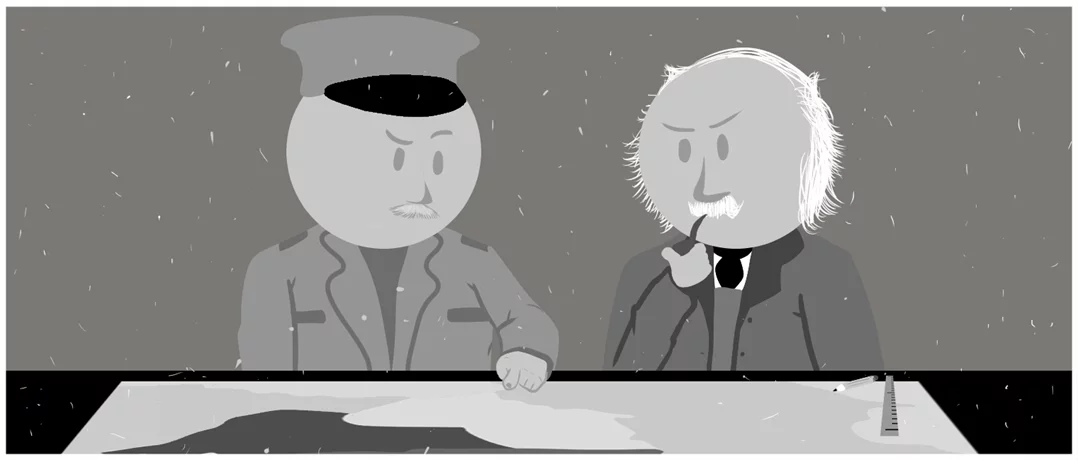The 1916 Sykes-Picot Agreement, dividing the Middle East between Britain and France, set the stage for a century of regional conflict and instability.
How a secret agreement destabilised the Middle East
How a secret agreement destabilised the Middle East


From the present bloodshed in Gaza to the wars in Iraq and insurgency in Syria, can the blame for these conflicts be placed at the feet of two European diplomats a century ago? Leading scholars believe that the top-secret Sykes-Picot agreement, drafted by Britain and France in 1916, has blighted the lives of millions in the Middle East.
The Sykes-Picot Agreement was secretly ratified in May 1916. It was only made known to the public by the Bolsheviks when they seized power in Russia in 1917. It revealed how the western powers intended to carve up the Middle East.
Drawing borders in secret
In 1916, the First World War raged across Europe, yet it was becoming obvious that once peace was achieved, some old empires and monarchies were not going to survive. The biggest casualty would be the Ottoman Empire, centred on modern Turkey, which had ruled most of the Levant and Arabian Peninsula for centuries. By the mid-19th century, the Ottomans were seen as a “sick man”, kept on life support by Britain and France.
The Ottomans unwisely sided with Germany in World War One which gave Britain and France the perfect excuse to carve up the sultan’s Arab territories into “mandates” ruled from London and Paris. Two career diplomats, Sir Mark Sykes (1879-1919) of the British war office and François Georges-Picot (1870-1951), French consul in Beirut, drew lines on a map. Syria and Lebanon would come under French control while Palestine, Jordan and Iraq would be supervised by the British.
Jerusalem was to be under international control to pacify the Russian empire. Events quickly undermined this part of the Sykes-Picot plan. In taking control of Palestine, Britain simply swallowed up Jerusalem. The French gave into this new reality while the Russian tsar was overthrown by the Bolsheviks in 1917 who were indifferent to previous tsarist diplomacy.
Broken promises and betrayals
The revelation of Sykes-Picot was seen as a betrayal by Arabs. It had been preceded between 1914 and 1915 by a secret correspondence between Sir Henry McMahon (1862-1949), the British High Commissioner in Cairo, and Husayn Ibn Ali, the Sharif of Mecca. This resulted in the British pledging to support Hussein’s bid for leadership of the Arab world provided he helped overthrow the Ottomans. The now publicised Sykes-Picot accord showed that earlier correspondence was a sham.
To add insult to injury, Britain also issued The Balfour Declaration in 1917, which publicly declared support for a Jewish national homeland in Palestine, while claiming this would not prejudice the rights of non-Jewish communities. This was, in effect, a foundational document for the future state of Israel.
The shadow of Sykes-Picot today
Fawaz Gerges is Professor of International Relations at the London School of Economics and Political Science. His latest book, The Great Betrayal: The Struggle for Freedom and Democracy in the Middle East, examines how Sykes-Picot, and other meddling by western powers, denied people in the Middle East any agency in determining their own future.
“The modern Middle East was invented by colonial Britain and France between 1916 and the 1920s.
The Balfour Declaration and the Sykes-Picot agreement represent the original sin that continues to haunt the region. There’s no question in his mind that Sykes-Picot has cast a long shadow. More than any other great power, Britain is the most responsible for the unfolding tragedies of the Palestinians
Nadia Naser-Najjab is a senior lecturer in Palestine Studies at Exeter University’s Institute of Arab and Islamic Studies. She argues that the Hussein-McMahon correspondence, Sykes-Picot, and Balfour Declaration represent Britain’s “legacy of duplicity” in Palestine. Britain both declared for a Jewish homeland while also committing to Palestinian independence. But, behind closed doors, it put the Zionist agenda above the aspirations of the Palestinian people.
Everything that has happened over the last century from the partition of Palestine to the establishment of Israel and the Palestinian Nakba has its roots in that secret agreement: “They are part of a broader colonial legacy that began with the 1916 Sykes-Picot Agreement, in which Britain and France carved up the Middle East to serve their imperial interests. This secret agreement is the basis for foreign intervention, destabilisation, and imposed borders and enabling the colonisation of Palestine”.
Ironically, Naser-Najjab continues, today’s Israeli politicians are effectively tearing up the Sykes-Picot agreement by ignoring its recommended borders. Figures close to the Israeli leadership “vow to expand beyond historic Palestine, targeting areas in Lebanon, Syria, Jordan, and even Saudi Arabia”.
Not everybody buys into the argument that the blame for today’s woes in the region can be laid at the door of Sykes-Picot. Dr Elizabeth Monier is Assistant Professor of Modern Arabic Studies at the University of Cambridge: “Linking today’s conflicts to the Sykes-Picot agreement oversimplifies the complexity of contemporary Middle Eastern politics."
Its real legacy is symbolic – a lasting sense of betrayal and trust
So, the unfolding horror in Gaza is driven less by a century-old agreement between two Victorian era European diplomats and more by the failure to uphold international law and the rules-based order. That is the cause of today’s deepening tragedy in Monier’s view.
There can be little doubt though that Sykes-Picot set a precedent for the mendacity and treachery that many in the region believe has been a hallmark of the western approach to their conflicts and wars. Worse, backroom dealings like Sykes-Picot, and a plethora of agreements since, have fuelled bloodshed because these clandestine treaties are driven by self-interest more than the interest of the Arab people.


